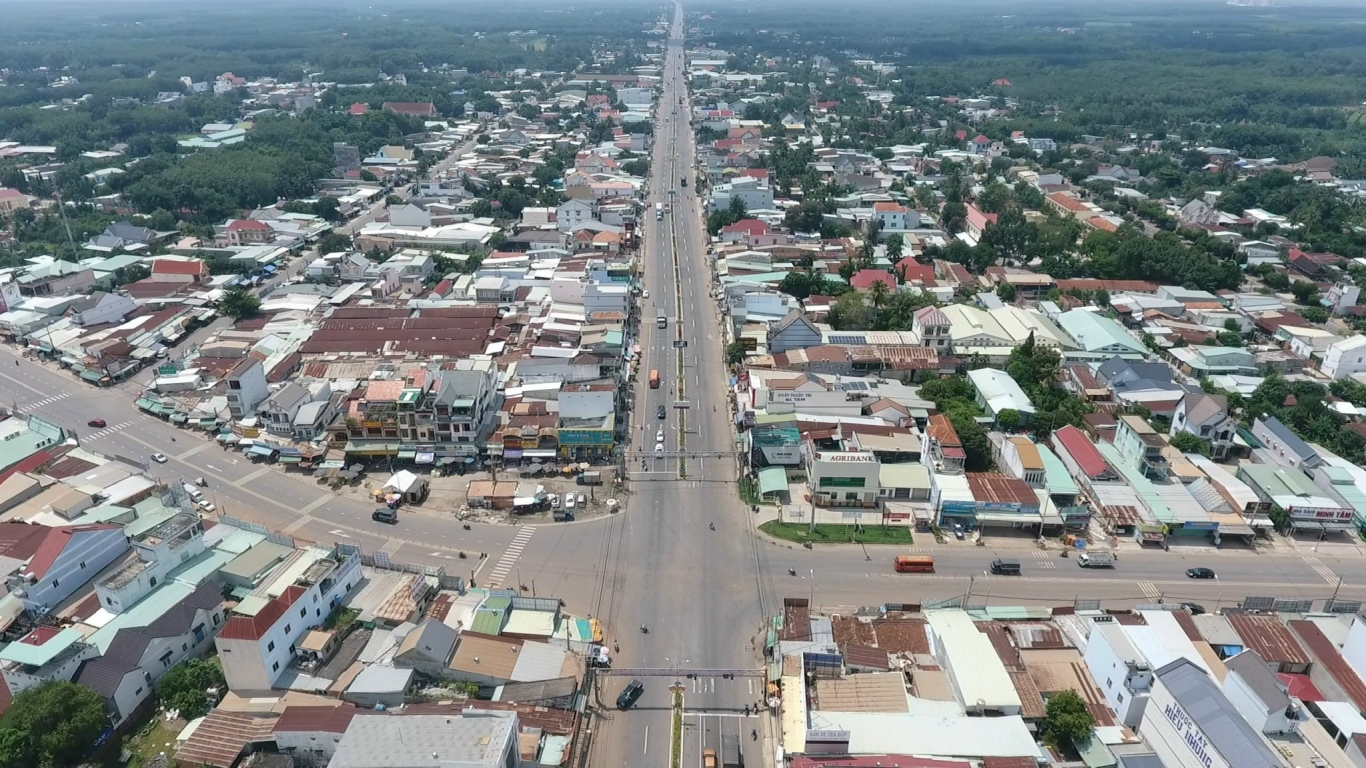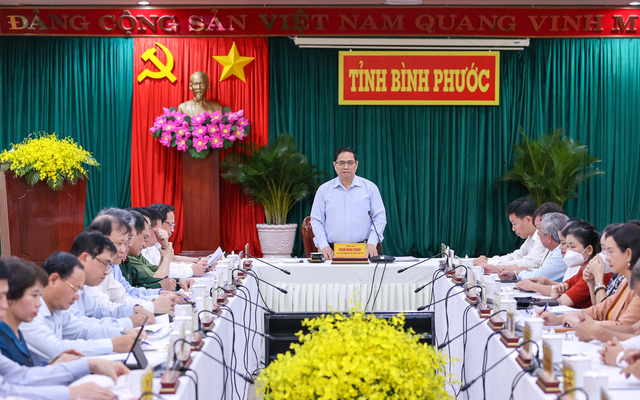(BP Portal) - From land ravaged by war bombs, Binh Phuoc is now rising. "The opportunity is becoming clearer than ever, and if exploited well, Binh Phuoc could shift from the 'development reserve' position to the 'development driving force' of both the Southeast and the country," evaluated by the Fulbright University economics group Vietnam.
Binh Phuoc province has an area of 6,877 km2; with a population of almost one million, in the "golden population" of about 600,000 working age people
From a land that carries many injuries by bombs
According to the former Provincial Secretary Binh Phuoc - Nguyen Van Loi, due to war requirements, in 1962 the Central Bureau decided to merge Binh Long, Phuoc Long and Lam Dong provinces into Zone 10. District 10 people's officers, soldiers, and soldiers staunchly joined the nation's militia in crushing the U.S. Empire's strategy of "Special War", "local War", and "Vietnamization of war".
In response to this new task, on January 30, 1971, the Central Bureau issued a resolution to dissolve Zone 10 merging the Binh Long and Phuoc Long provinces to form the Binh Phuoc province.
On March 23, 1975, the center of Binh Long Province, where the US-Wei central government apparatus is located has completely collapsed, Binh Phuoc was liberated. This marked an especially important history in the struggle of Binh Phuoc's troops and civilians together with the whole country as a general offensive and in the spring of 1975, complete liberation of the South, and unification of the country. March 23 became the pride of Binh Phuoc's party, government, and people.
Following the victory of the Anti-American Resistance, on 2 July 1976 at the sixth Session of the National Assembly, the National Assembly of the Socialist Republic of Vietnam decided to create the Song Be Province.
In 1997, Song Be Province split its administrative boundaries into Binh Duong and Binh Phuoc provinces. At the time of its inception, Binh Phuoc was one of the poorest provinces in the country; The ethnic life of the province is very difficult and the average GDP per capita is close to $180; Poor, backward facilities and provincial staff are seriously undercut. Agriculture and forestry, with over 70% of the population; small industries, trade and services; Infrastructure low, unsynchronized; As a result, there is a growing number of free migration, some 20% of ethnic minorities with low literacy.
Huynh Anh Minh - The vice chairman of Binh Phuoc provincial People's Committee said: From an economic size of just 1,200 billion in 1997, more than VND77,800 billion by 2021. The main economic structure of the agro-forestry economy during this period was 71.6 percent; by now, agriculture and forestry have fallen to 23.3 percent; Industry share grew out of 3%, so far 42.3%; Per capita income of 2.6 million rose to 76 million VND per capita per annum.
"If in 1997, provincial budget revenues were only 172 billion VND, 2021 Binh Phuoc would have collected nearly VND 13,700 billion, nearly 80 times as much; Export revenues totaled $3.5 billion, an increase over 100 times; Attracting foreign direct investment was almost $3.6 billion, 175 times higher", information from Mr.Minh.
The "Development Reserve" Region of the Southeast
Ms. Tran Tue Hien - The president of the Binh Phuoc provincial Peoples' Committee said Binh Phuoc lies within the key economic zone in the south and that Binh Phuoc has an important strategic position in the economic, political and security development of the south and the country as a whole. The province has an area of 6,877 km2; with a population of almost one million, in the "golden population" of about 600,000 working age people; It is about 80 km from the center of Ho Chi Minh City. Binh Phuoc has a relatively good transport infrastructure to connect with Tay Nguyen and the Southeastern provinces via National Highway 13, National Highway 14 and DT 741, which has a scale of six to eight lanes that are very convenient for traffic and freight.
Binh Phuoc currently has 13 industrial zones with a total area of 4,686 ha and 8 industrial clusters with an area of 380 ha; 11 of these zones have been fully invested in infrastructure and are operational. The Prime Minister has approved the policy for Binh Phuoc to expand three industrial zones. By 2030, Binh Phuoc will continue to plan new and expand some industrial zones into an area of about 9,300 hectares.
In addition, Binh Phuoc has the Hoa Lu International Border-gate Economic Zone, which borders the Kingdom of Cambodia and connects with Laos and Thailand with a total area of 28,300 hectares, of which over 3,500 hectares of the central area has been operational.
At the meeting with the Standing Committee of Binh Phuoc provincial Party Committee on March 20, 2022, the Prime Minister of Pham Minh Chinh assessed Binh Phuoc as a strategic landmark, connecting the Tay Nguyen provinces to the city of Ho Chi Minh in the Southeast region, with 260 km of border with the Cambodia. The province is relatively flat, fertile land, and is the "capital" of the rubber tree and so; The climate was mild and there’s no storm flooding. Binh Phuoc is in a position to develop comprehensive, fast, sustainable and advantageous industries and agriculture, and clean energy.
"Over 25 years of construction and development, Binh Phuoc province has achieved certain results and has contributed to the overall achievement of the country. In particular, the province has well controlled the epidemics, growth in GRDP by 2021 was the first in the South East and the 20th in the country as a major provincial effort," measured by Prime Minister Pham Minh Chinh.
The Prime Minister of Pham Minh Chinh assessed Binh Phuoc as a strategic landmark, connecting the Tay Nguyen provinces to the city of Ho Chi Minh in the Southeast region. Photo: Nhat Bac.
The steel land blooms
At the "Binh Phuoc 25 years of Journey of Ambition to rise" seminar organized by Binh Phuoc provincial Peoples' Committee in January 2022, Associate Professor Ph.D Tran Dinh Thien - the Head of the Viet Nam Institute of Economics, said that Binh Phuoc lies in the southern key economic region, enjoying a strong development spread and likely to create a joint development dynamics.
"Binh Phuoc is a hub for south-southwest communication with the southern economic focal region, where the airport and maritime International Transit Port, of which Ho Chi Minh City is the nuclear, terminal. Binh Phuoc lies in the east-west corridor connecting northwestern SAEAN with huge growth potential”. Associate Professor Ph.D Tran Dinh Thien is noted and noting that" Binh Phuoc had the advantage over some provinces and provinces of the region to "backers". This allows the province to make the most of its "prepared" markets, development experience and other resources such as international port of Transshipment, connecting roads, and business forces".
In its "Binh Phuoc Province Competitiveness Assessment report and its strategic orientation 2030 Vision 2050, plan and Program of Action 2020-2025", the Fulbright University economics group of Vietnam believes that Binh Phuoc is facing and facing challenges both in the present and in the future.
According to the Fulbright University Economist Group, as the economic activities in Ho Chi Minh City are now widening and expanding, the opportunity begins to reach more distant localities. Binh Phuoc, where the gateway to the center of the southern key economic region with the Tay Nguyen began to develop conditions, opportunities became clearer.
In the context of the effects of climate change and sea rise, the Cuu Long River delta and the Southeast will be very affected over the next decades. "While Binh Phuoc is unaffected, the chances of becoming the regional center or drive for development are few decades from now," said the Fulbright University economics team Vietnam./.
Written by: Sy Tuyen - Translator: Ms.Thao

